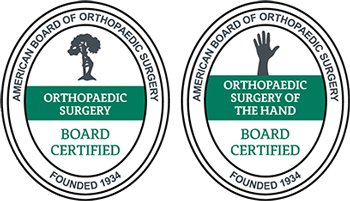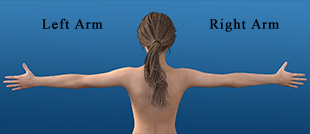Wrist Pain in Dallas

Because of the wide range of motion needed to function properly, wrists are made up of several joints, bones, tendons, ligaments, nerves, and blood vessels, making them one of the most complex structures in the human body. This complexity makes the wrist that much more vulnerable to serious injuries and conditions, such as fractures, ligament tears, and more. While the wrist, or carpus, is made up of eight bones in total, the carpal bones are the most commonly injured. Like most extremity injuries, wrist injuries can range from very mild to incredibly severe, depending on the cause and type of injury. The severity of the injury will be a major deciding factor in when to see a doctor.
The following are the most common wrist conditions we see in our practice. Follow the links below to learn more details and information on each condition, including causes, symptoms, when to see a doctor, and surgical and non-surgical treatments.
- Advanced Wrist Arthroscopy
- Carpal Tunnel Syndrome
- Cartilage and Ligament Tears of the Wrist
- Colles Fracture
- ECU Subluxation
- Ganglion Cyst
- Intersection Syndrome
- Kienbocks Disease
- Metacarpal Boss
- Radial Tunnel Syndrome
- Scaphoid Fracture
- Wrist Fractures
- Wrist Sprain
- Ulnar Tunnel Syndrome
 
Wrist Sprains
Wrist sprains occur when you overstretch or tear the ligaments in the wrist. This could be due to a fall, impact, or a sudden twisting motion. If you’ve sprained your wrist, you may notice pain, swelling, and bruising, and may also experience limited mobility in your wrist. To treat a sprain, we use the rest, ice, compression, elevation (RICE) method. Besides the RICE method, we may sometimes use a splint. If you have a severe sprain, you may even need physical therapy.
Carpal Tunnel Syndrome
Carpal tunnel syndrome is a common wrist injury. It occurs when the median nerve in the wrist becomes compressed. This is often due to repetitive hand and wrist movements, such as typing, and can indicate underlying medical conditions or even pregnancy. Symptoms include numbness, tingling, and pain in the hand and fingers, especially at night. To treat carpal tunnel, we use wrist splints, anti-inflammatory medications, and corticosteroid injections. If your case is severe, we may recommend surgery to relieve pressure on the nerve.
Tendonitis
Tendonitis, or tenosynovitis, occurs when the wrist tendons become inflamed. Repetitive hand and wrist movements, including typing and playing sports, can cause it. Symptoms include pain, swelling, and difficulty moving the wrist or hand. To treat tendonitis, we recommend resting the wrist and may prescribe anti-inflammatory medications and the use of a splint. You may also need physical therapy to reduce inflammation and strengthen the wrist.
Gout
Gout is an excess of uric acid in the body, leading to urate crystals forming in the wrist joint. Symptoms include intense pain, swelling, redness, and warmth in the wrist. You may also experience other symptoms, such as a fever or chills. To treat gout, we prescribe medication to reduce uric acid and inflammation. We also recommend lifestyle changes to prevent future gout attacks.
A Dislocated or Broken Wrist
You can dislocate your wrist as a result of a fall or forceful impact that pushes your bones out of alignment. Symptoms can include severe pain, deformity, swelling, and limited mobility. We need to realign the bones to treat a dislocation or broken wrist. You’ll then need to keep your wrist in a cast or splint. Surgery may even be necessary in severe cases.
Arthritis
Osteoarthritis, rheumatoid arthritis, and other autoimmune conditions can affect the wrist joint. Symptoms include pain, stiffness, swelling, and reduced range of motion in the wrist. To treat wrist issues resulting from arthritis, we prescribe medication to help manage the pain and inflammation. You may also need physical therapy and assistive devices.
Wrist Fractures
You can fracture or break your wrist as a result of a fall, sports injury, or accident. Symptoms include pain, swelling, bruising, deformity, and difficulty moving the wrist. To treat a fracture, we immobilize the joint with a cast or splint. In some cases, we may recommend surgery to realign and fix the bones so they can heal properly.
Ganglion Cysts
Nobody knows what causes ganglion cysts. They usually result from joint or tendon irritation. Ganglion cysts form fluid-filled lumps on the wrist and result in discomfort and pain. To treat the cyst, we remove the fluid through aspiration or even surgery in severe cases.
Tips for Preventing Common Wrist Injuries
Preventing common wrist injuries is essential. This is especially important if you play sports that place stress on these areas. Here are some valuable tips to help prevent common wrist injuries:
- Practice ergonomics: Use an ergonomic keyboard and mouse to align your wrist. This can help reduce strain during tasks such as typing.
- Take regular breaks: Take brief breaks to rest and stretch. This is vital if your job or hobbies involve repetitive wrist movements.
- Stretch and warm up: Stretch your hands and wrists often, especially before playing sports. Gentle wrist circles and flexor stretches can be effective.
- Strengthen your wrist muscles: Add wrist-strengthening exercises to your routine. Simple exercises with resistance bands or light weights can build strength and stability.
- Wear protective gear: Wear wrist guards, braces, or wraps during sports. The right gear can provide additional support and reduce the chances of injury.
- Use proper techniques: Focus on your form when weightlifting or playing musical instruments. This can minimize strain on your wrists.
- Don’t overexert: Don’t put too much pressure on your wrist by lifting heavy objects. Use tools or equipment and ask for help if necessary.
- Stay hydrated: Drinking plenty of water can keep your tendons and ligaments supple. Dehydrated tissues are more prone to injury.
- Eat well: A balanced diet rich in nutrients and vitamins keeps the joints and tissues healthy, reducing the risk of injury and inflammation.
- Stay active: Regular physical activity improves strength, flexibility, and joint health, and exercises that target the wrists, such as yoga, can also be beneficial.
- Listen to your body: Pay attention to any discomfort or pain in your wrists. If you experience persistent symptoms, seek medical attention immediately to prevent further injury.
- Use assistive devices: Use ergonomic tools, padded mouse pads, or voice recognition software. This can help to reduce the strain on your wrists.
When To See Dr. Knight
By taking preventive measures as part of your daily routine, you can reduce the risk of wrist injury. Early diagnosis and treatment are essential to preventing complications and promoting faster healing. If you suspect you may have a wrist injury, consult a healthcare professional as soon as possible. Our Dallas hand surgeons at the Hand and Wrist Institute are here to help you take your first steps on the road to recovery. Contact us and book an appointment today for an accurate diagnosis and personalized treatment plan.
























